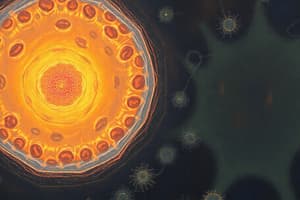Podcast
Questions and Answers
Which of the following statements is true regarding prokaryotic cells?
Which of the following statements is true regarding prokaryotic cells?
- They contain a nucleus surrounded by a double membrane.
- They usually have more than one chromosome.
- They multiply by fission. (correct)
- They have membrane-bound organelles.
What is the primary distinction between prokaryotic and eukaryotic cells?
What is the primary distinction between prokaryotic and eukaryotic cells?
- Eukaryotic cells have a nucleus while prokaryotic cells do not. (correct)
- Prokaryotic cells have membrane-bound organelles.
- Eukaryotic cells lack genetic material.
- Prokaryotic cells are larger than eukaryotic cells.
Eukaryotic cells are always unicellular.
Eukaryotic cells are always unicellular.
False (B)
All living organisms are made up of cells.
All living organisms are made up of cells.
What type of cell division do eukaryotic cells undergo?
What type of cell division do eukaryotic cells undergo?
What are the four classes of large biological molecules found in living organisms?
What are the four classes of large biological molecules found in living organisms?
The __________ provides a boundary that separates the cell from its surroundings.
The __________ provides a boundary that separates the cell from its surroundings.
Match the cell types with their characteristics:
Match the cell types with their characteristics:
The __________ is a selectively permeable boundary that surrounds a cell.
The __________ is a selectively permeable boundary that surrounds a cell.
Which organelle is primarily responsible for energy production in eukaryotic cells?
Which organelle is primarily responsible for energy production in eukaryotic cells?
What is a major difference in the size of prokaryotic and eukaryotic cells?
What is a major difference in the size of prokaryotic and eukaryotic cells?
Prokaryotic cells typically have a nucleus.
Prokaryotic cells typically have a nucleus.
Nucleolus is absent in both prokaryotic and eukaryotic cells.
Nucleolus is absent in both prokaryotic and eukaryotic cells.
Cells combine to form __________, which are groups of similar cells that perform a specific function.
Cells combine to form __________, which are groups of similar cells that perform a specific function.
Give an example of a prokaryotic cell.
Give an example of a prokaryotic cell.
Match the type of cell to its characteristic:
Match the type of cell to its characteristic:
What characteristic differentiates prokaryotic cells from eukaryotic cells?
What characteristic differentiates prokaryotic cells from eukaryotic cells?
Eukaryotic cells are generally smaller than prokaryotic cells.
Eukaryotic cells are generally smaller than prokaryotic cells.
Who coined the term 'cell' and in what year?
Who coined the term 'cell' and in what year?
All cells come from ________ through cell division.
All cells come from ________ through cell division.
Match the following cell types with their characteristics:
Match the following cell types with their characteristics:
Which of the following is NOT a common feature of both prokaryotic and eukaryotic cells?
Which of the following is NOT a common feature of both prokaryotic and eukaryotic cells?
Prokaryotic cells contain membrane-bound organelles.
Prokaryotic cells contain membrane-bound organelles.
What are the domains that consist of prokaryotic cells?
What are the domains that consist of prokaryotic cells?
Flashcards are hidden until you start studying
Study Notes
Eukaryotic vs Prokaryotic Cells
- Prokaryotic cells lack a membrane-bound nucleus, while eukaryotic cells have a nucleus encased in a double membrane.
- Prokaryotes typically have a single circular chromosome; eukaryotes contain multiple linear chromosomes.
- Nucleolus is absent in prokaryotic cells but present in eukaryotic cells.
- Membrane-bound organelles are absent in prokaryotic cells; eukaryotic cells have various organelles such as mitochondria and endoplasmic reticulum.
- Cell division in prokaryotes occurs by fission; eukaryotic division occurs via mitosis or meiosis.
- Prokaryotic cells have complex cell walls; plant cells (eukaryotes) have simpler cell walls compared to prokaryotes.
- Prokaryotic cells are generally unicellular, while eukaryotic cells can be unicellular or multicellular.
- Prokaryotic cell size ranges from 1-10μm; eukaryotic cell size is typically 10-100μm.
- Examples of prokaryotic cells include bacteria and archaea; examples of eukaryotic cells are animal and plant cells.
Eukaryotic Cell Structure
- Key components include the plasma membrane, nucleus, cytoplasm, nucleolus, inclusion bodies, nuclear envelope, cytoplasmic matrix, organelles, and cytoskeletal structures.
- The plasma membrane acts as a barrier separating the cell from its external environment.
Biological Organization
- Life is organized hierarchically, from atoms and molecules to biospheres.
- Levels of organization: atom, molecule, organelle, cells, tissues, organs, organ systems, organisms, populations, communities, ecosystems, biosphere.
- Atoms form molecules through chemical bonds; biologically significant molecules include carbohydrates, lipids, proteins, and nucleic acids.
- Macromolecules are large polymers formed from monomers; three polymer classes are carbohydrates, proteins, and nucleic acids.
Cell Theory
- All living organisms consist of cells, which are the smallest functional units.
- Cells arise from pre-existing cells through cell division.
Types of Cells
- Two primary cell types: prokaryotic and eukaryotic.
- Prokaryotic cells are found in bacteria and archaea; eukaryotic cells are present in protists, fungi, animals, and plants.
Prokaryotic Cell Characteristics
- No nucleus; DNA is in a nucleoid region.
- Absence of membrane-bound organelles.
- Cytoplasm is enclosed by a plasma membrane.
Eukaryotic Cell Characteristics
- DNA is located within a membrane-bound nucleus.
- Presence of membrane-bound organelles.
- Generally larger than prokaryotic cells.
- Cytoplasm exists between the plasma membrane and nucleus.
Common Features of Both Cell Types
- Both prokaryotic and eukaryotic cells share a plasma membrane, cytoplasm (cytosol), chromosomes (containing genes), and ribosomes for protein synthesis.
Studying That Suits You
Use AI to generate personalized quizzes and flashcards to suit your learning preferences.




